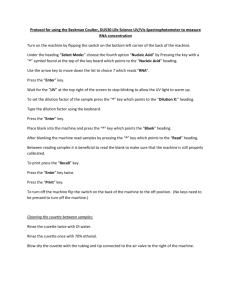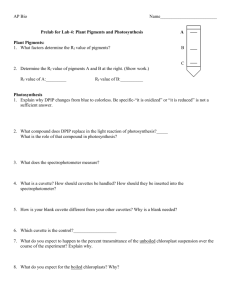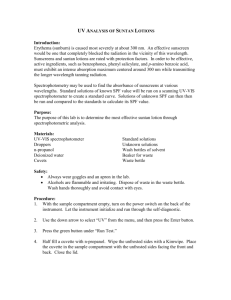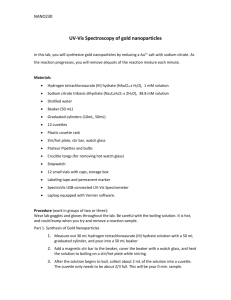ANALYSIS OF SUNCREENS INTRODUCTION
advertisement
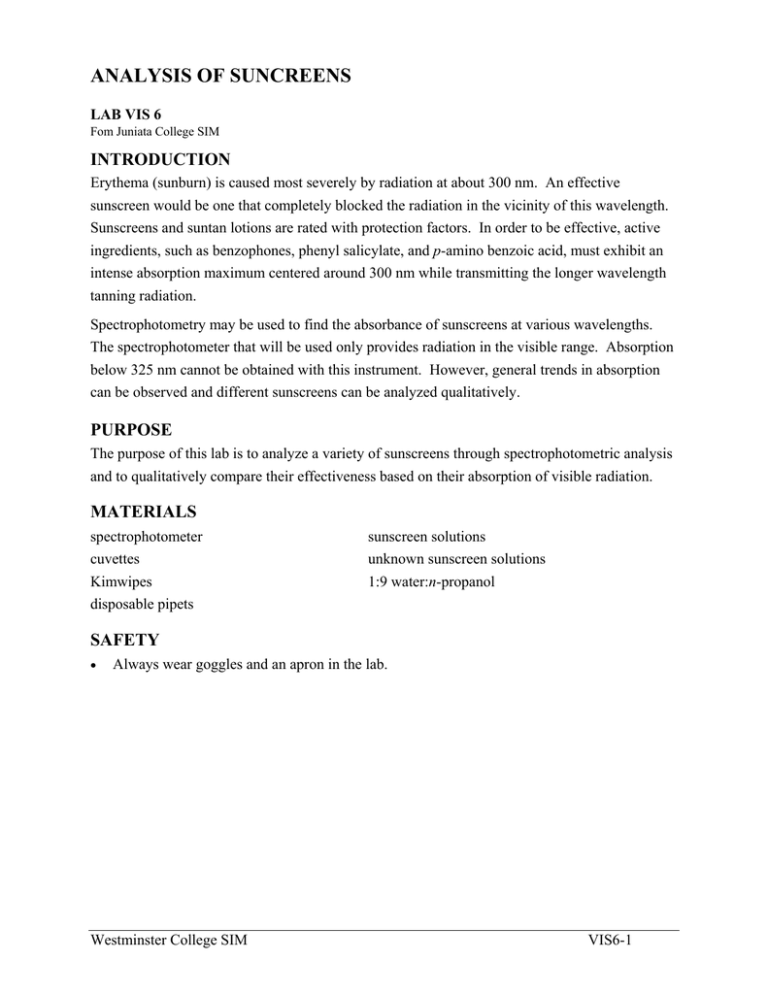
ANALYSIS OF SUNCREENS LAB VIS 6 Fom Juniata College SIM INTRODUCTION Erythema (sunburn) is caused most severely by radiation at about 300 nm. An effective sunscreen would be one that completely blocked the radiation in the vicinity of this wavelength. Sunscreens and suntan lotions are rated with protection factors. In order to be effective, active ingredients, such as benzophones, phenyl salicylate, and p-amino benzoic acid, must exhibit an intense absorption maximum centered around 300 nm while transmitting the longer wavelength tanning radiation. Spectrophotometry may be used to find the absorbance of sunscreens at various wavelengths. The spectrophotometer that will be used only provides radiation in the visible range. Absorption below 325 nm cannot be obtained with this instrument. However, general trends in absorption can be observed and different sunscreens can be analyzed qualitatively. PURPOSE The purpose of this lab is to analyze a variety of sunscreens through spectrophotometric analysis and to qualitatively compare their effectiveness based on their absorption of visible radiation. MATERIALS spectrophotometer cuvettes Kimwipes disposable pipets sunscreen solutions unknown sunscreen solutions 1:9 water:n-propanol SAFETY • Always wear goggles and an apron in the lab. Westminster College SIM VIS6-1 Analysis of Sunscreens PROCEDURE 1. Using a disposable pipet, fill a cuvette ¾ full with 1:9 water:n-propanol to be used as a blank. This is the “blank cuvette”. 2. Press A/T/C Button on the Spectronic 20 Genesys. Select absorbance. 3. Press the nm arrow up or down and select 350 nm. 4. Place the blank cuvette into the sample compartment of the spectrophotometer with the triangle on the cuvette facing the front of the instrument. Note: Before inserting a cuvette into the spectrophotometer, wipe it clean and dry with a kimwipe, and make sure that the solution is free of bubbles. Do not touch the clear sides of the cuvette. 5. Press 0 ABS 100%T. 6. Remove the blank cuvette. 7. Select a sunscreen sample to analyze. 8. Using a disposable pipet, rinse a second cuvette with a small amount of sunscreen solution and then fill the cuvette ¾ full. This is the “sample cuvette”. 9. Insert the sample cuvette into the cell holder. Do not press 0 ABS 100%T after inserting the sample cuvette. 10. The sample measurement appears on the LCD display. Record the absorbance in the Data Table. 11. Continue to take readings at 5 nm intervals to 365 nm. Remember to zero the instrument using the blank at every wavelength. 12. Repeat this procedure for another sunscreen or unknown, as directed by your instructor. 13. Graph absorbance versus wavelength. If analyzing multiple samples, use different colors for the various samples or different point protectors on a computer-graphing program for each sample tested. Westminster College SIM VIS6-2 Analysis of Sunscreens DATA SHEET Name Name Period Date ________________________ ________________________ _______ Class ___________ ___________ ANALYSIS OF SUNCREENS DATA TABLE Wavelength (λ) SPF _____ SPF _____ Unknown # _____ 350 355 360 365 Estimated Unknown SPF: ______ QUESTIONS 1. What sunscreen blocked the lower wavelengths most effectively? How can you tell? 2. Overall, which sunscreen would you chose? Explain your choice. 3. Use the graphs of absorbance versus wavelength for the sunscreens to estimate the SPF of the unknown sunscreens. Westminster College SIM VIS6-3

